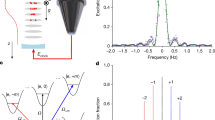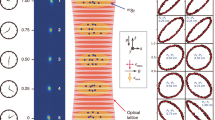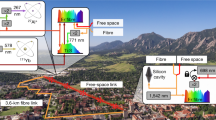Abstract
Arising from: H. Müller, A. Peters & S. Chu Nature 463, 926–929 (2010)10.1038/nature08776; Müller & Chu reply
In ref. 1 the authors present a re-interpretation of atom interferometry experiments published a decade ago2. They now consider the atom interferometry experiments2 as a measurement of the gravitational redshift on the quantum clock operating at the Compton frequency ωC = mc2/ ≈ 2π × 3.0 × 1025 Hz, where m is the caesium (Cs) atom rest mass. They then argue that this redshift measurement compares favourably with existing3 as well as projected4 clock tests. Here we show that this interpretation is incorrect.
≈ 2π × 3.0 × 1025 Hz, where m is the caesium (Cs) atom rest mass. They then argue that this redshift measurement compares favourably with existing3 as well as projected4 clock tests. Here we show that this interpretation is incorrect.
Similar content being viewed by others
Main
Since their publication, atom interferometry experiments of this type have been analysed as measuring the acceleration of free fall of Cs atoms in the interferometer, leading to a test of the universality of free fall (UFF) through a comparison with measurements using a freely falling corner cube. Although it remains less sensitive than tests using macroscopic test masses of different composition5,6 (relative precision 7 × 10−9 versus 2 × 10−13), this UFF test is very important because it is the most sensitive test that compares the free fall of quantum bodies with that of classical test masses.
But do such experiments measure the gravitational redshift? We first emphasize that the atom interferometer used in ref. 2 is an accelerometer (or gravimeter). The associated signal is a phase shift Δϕ = k·g T2, where k is the effective wavevector transferred by lasers, g is the local acceleration of gravity and T is the interrogation time. It measures the acceleration of freely falling atoms, as defined with respect to the experimental platform that holds the optical and laser elements. With k and T known from auxiliary measurements, one deduces the component of g along the direction of k. If the whole instrument was put into a freely falling laboratory, the phase shift Δϕ would vanish.
The situation is completely different for instruments used for testing the universality of clock rates (UCR). An atomic clock delivers a periodic electromagnetic signal the frequency of which is actively controlled to remain tuned to an atomic transition. The clock frequency is sensitive to the gravitational potential U and not to the local gravity field g = ∇U. UCR tests are then performed by comparing clocks through the exchange of electromagnetic signals; if the clocks are at different gravitational potentials, this contributes to the relative frequency difference by Δv/v = ΔU/c2.
We show now that ref. 1 does not measure the gravitational redshift. This is clearly seen when evaluating the phase shift Δϕ using a Lagrangian formulation as employed in ref. 1; the Lagrangian may for example have the form considered in equation (8) of ref. 1. It can then be proved that the clock contribution Δϕfree discussed in ref. 1—that is, the difference of Compton phases along the two paths—is exactly zero for a closed total path (equation (81) in ref. 7), or exactly cancelled by a second contribution associated with the splitting of the endpoints of these paths8. The final phase shift Δϕ then arises entirely from a third contribution describing the interaction of light with atoms in the beam-splitting process. This explains why the phase shift takes the already discussed expression k·g T2, which does not depend on the Compton frequency ωC.
The key point in this cancellation is a consistent calculation of the two paths in the atom interferometer as well as of the phases along these paths, both derived from the same Lagrangian by using the principle of least action in a standard way. When this is done in the case of ref. 1, we find that their equation (8) gives Δϕfree = 0, irrespective of the value of the redshift violation parameter β. If one doubts the validity of this principle of least action, the significance and sensitivity of the test of ref. 1 remains to be evaluated9.
To summarize, the experiment discussed in refs 1 and 2 is an interesting test of UFF but not a measurement of the gravitational redshift or a test of UCR. Both kinds of tests (UFF and UCR) have their own merit, because they check in different ways whether all types of mass-energy are universally coupled to gravitation10.
References
Müller, H., Peters, A. & Chu, S. A precision measurement of the gravitational redshift by the interference of matter waves. Nature 463, 926–929 (2010)
Peters, A., Chung, K. Y. & Chu, S. A measurement of gravitational acceleration by dropping atoms. Nature 400, 849–852 (1999)
Vessot, R. F. C. et al. Test of relativistic gravitation with a space-borne hydrogen maser. Phys. Rev. Lett. 45, 2081–2084 (1980)
Cacciapuoti, L. & Salomon, C. Space clocks and fundamental tests: the ACES experiment. Eur. Phys. J. Spec. Top. 127, 57–68 (2009)
Williams, J. G., Turyshev, S. G. & Boggs, D. H. Progress in lunar laser ranging tests of relativistic gravity. Phys. Rev. Lett. 93, 261101 (2004)
Schlamminger, S. et al. Test of the equivalence principle using a rotating torsion balance. Phys. Rev. Lett. 100, 041101 (2008)
Storey, P. & Cohen-Tannoudji, C. The Feynman path integral approach to atomic interferometry. A tutorial. J. Phys. II 4, 1999–2027 (1994)
Bordé, C. J. 5D optics for atomic clocks and gravito-inertial sensors. Eur. Phys. J. Spec. Top. 163, 315 (2008)
Will, C. M. Theory and Experiments in Gravitational Physics Ch. 2 (Cambridge University Press, 2000)
Damour, T. Experimental tests of gravitational theory. In The Review of Particle Physics (ed. Amsler, C. et al.) Phys. Lett. B667 1 (2008) 〈http://pdg.lbl.gov/〉.
Author information
Authors and Affiliations
Ethics declarations
Competing interests
declared none.
Rights and permissions
About this article
Cite this article
Wolf, P., Blanchet, L., Bordé, C. et al. Atom gravimeters and gravitational redshift. Nature 467, E1 (2010). https://doi.org/10.1038/nature09340
Received:
Accepted:
Issue Date:
DOI: https://doi.org/10.1038/nature09340
This article is cited by
-
Gravitational redshift and the vacuum index of refraction
Astrophysics and Space Science (2019)
-
Wayward satellites repurposed to test general relativity
Nature (2015)
-
Summary of session C9: experimental gravitation
General Relativity and Gravitation (2014)
-
Quantum interferometric visibility as a witness of general relativistic proper time
Nature Communications (2011)
-
Müller, Peters & Chu reply
Nature (2010)
Comments
By submitting a comment you agree to abide by our Terms and Community Guidelines. If you find something abusive or that does not comply with our terms or guidelines please flag it as inappropriate.



